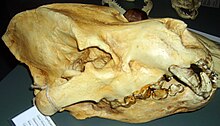
Back Percrocútids Catalan Percrocutidae German Percrocutidae Spanish Percrocutidae French פרקרוקוטיים HE Percrocutidae Hungarian Percrocutidae Italian Percrocutidae NB Percrocutidae Portuguese Percrocutidae Russian
| Percrocutidae Temporal range: Middle Miocene to Late Pliocene
| |
|---|---|

| |
| Dinocrocuta gigantea skull cast, Zoological Museum in Copenhagen | |
| Scientific classification | |
| Domain: | Eukaryota |
| Kingdom: | Animalia |
| Phylum: | Chordata |
| Class: | Mammalia |
| Order: | Carnivora |
| Suborder: | Feliformia |
| Superfamily: | Herpestoidea |
| Family: | †Percrocutidae Werdelin & Solounias, 1991 |
| Genera | |
Percrocutidae is an extinct family of hyena-like feliform carnivorans endemic to Asia, Africa, and Southern Europe from the Middle Miocene through the Pliocene, existing for about 8 million years.[1]
The first percrocutids are known from the middle Miocene of Europe and western Asia and belonged to the genus Percrocuta. Percrocuta already had large premolars, but did not carry such a massive bite as the later form Dinocrocuta, from the later Miocene.[2] Originally, these carnivores were placed with the hyenas in the family Hyaenidae. As of 2022[update], most scientists considered the Percrocutidae to be a distinct family that evolved their morphology similar to hyenas due convergent evolution,[3] - although they are usually placed sister-taxa/immediate outgroup to Hyaenidae.[4] Sometimes it was placed with the family Stenoplesictidae into the superfamily Stenoplesictoidea. A 2022 study placed Dinocrocuta and Percrocuta as true hyaenids, which if correct would invalidate the family Percrocutidae.[3]
- ^ Paleobiology Database: Percrocutidae basic information
- ^ Turner, Alan; Antón, Mauricio (2004). Evolving Eden: An Illustrated Guide to the Evolution of the African Large-mammal Fauna. New York: Columbia University Press. ISBN 0-231-11944-5.
- ^ a b Xiong, Wuyang (2022-05-01). "New species of Percrocuta (Carnivora, Hyaenidae) from the early middle Miocene of Tongxin, China". Historical Biology. 35 (5): 799–820. doi:10.1080/08912963.2022.2067757. ISSN 0891-2963. S2CID 248627038.
- ^ Figueirido, Borja; Tseng, Zhijie Jack; Martín-Serra, Alberto (2013). "Skull Shape Evolution in Durophagous Carnivorans". Evolution. 67 (7): 1975–1993. doi:10.1111/evo.12059. hdl:10630/32909. PMID 23815654. S2CID 23918004.